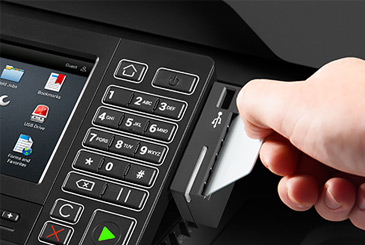
Configure every device to be consistently secure
The process of managing the device must also be secured so that the network traffic associated with the remote management can’t be sniffed, stolen or abused.
Lexmark understands the multi-faceted reality of security threats and responds with a holistic, systematic approach that encompasses the device, the fleet, and the whole network infrastructure.
Our understanding of network environments and relevant security threats, particularly in relation to printing, gives us the know-how to create unique solutions that secure your data in every possible way—a capability we’ve proven by working and overcoming security challenges in some of the most highly regulated organisations and industries on earth.
And our expertise pays off in concrete ways whether you manage your own printing infrastructure or rely on Lexmark Managed Print Services.

Securely remote manage a fleet of networked print and imaging devices
- Device and settings access
- Audit logging
- Encrypted and digitally signed firmware
- Secure boot technology
- Continuous verification
- Certificate Management
- Hard disc encryption
- Complete hard disc erasure
- Out of service wiping
Device and settings access
What makes Lexmark smart printers and multifunction products (MFPs) smart is their ability to run and configure apps that automate manual tasks, enhance security and guide users through your business processes with ease. But like any programmable devices with comprehensive configuration options, they should be as carefully protected as any PC or server on your network.
Lexmark devices include a variety of function access controls, authentication and authorisation mechanisms and an optional backup password to keep unauthorised users from altering the device’s settings, including security settings.
Audit logging
When you select Security Audit Log from the Security menu, Lexmark devices can track security-related events and device-setting changes.
The event-tracking feature proactively tracks and identifies potential risks and may be integrated with your intrusion detection system for real-time tracking.
Encrypted and digitally signed firmware
Lexmark devices inspect all downloaded firmware packages for a number of required attributes before the firmware is adopted or executed.
Firmware that’s not correctly packaged and signed by Lexmark is rejected.
Secure boot technology
Validate that the firmware installed on the printer is genuine Lexmark firmware.
Users receive notifications should non-genuine firmware is detected.
Continuous verification
The chain-of-trust process was developed by Lexmark to check and validate the integrity of a device’s operating system during startup, normal operation and execution of an internal application.
This ensures the firmware has not been tampered with during operation.
Certificate Management
Printers and MFPs use certificates for HTTPS, SSL, IPsec, and 802.1x authentications.
The Certificate Management feature allows the devices to integrate with a PKI environment by allowing the certificates to be signed, and also allows the devices to trust certificate authorities in the PKI environment.
Hard disc encryption
Hard discs in printers and MFPs can be configured to use encryption. An AES key, up to 256 bits, is internally generated by the printer or MFP and used to encrypt all data on the hard disc. The key is stored non-contiguously on the device, making the contents of the hard disc accessible only on the original printer or MFP.
The data on a stolen hard disc would not be accessible even if the hard disc was installed in an identical model of printer or MFP.
Out of service wiping
Simplify the process of clearing both a device’s disc drive and nonvolatile memory data when removing a device from service or removing it from a secure location.
Authorised users can do both in one step with the “out of service” wiping command, available from the device’s own configuration Menu or from the device’s Web page.
VIDEO
Markvision Enterprise Overview
[MP4 00:45]
Advanced easy-to-use toolset that realises a fast return on investment, while reducing the burden on your IT staff

Related Lexmark solutions
Analyst Reports
IDC MarketSpace Report
IDC MarketScape report names Lexmark a leader in Security Solutions and Services Hardcopy

